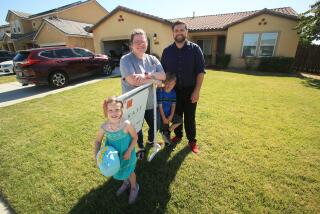Foreclosures of million-dollar-plus homes on the rise
- Share via
Foreclosure is blind.
After the mortgage meltdown and the plunge in home prices, record numbers of ordinary houses tumbled into foreclosure across Southern California as borrowers became unable or unwilling to pay their mortgages. But the rich aren’t so different after all: Million-dollar-plus homes have reverted to lender ownership in increasing numbers — previous sales prices, prime locations and even celebrity pedigrees have provided no immunity.
Earlier this year, Oscar-winning actor Nicolas Cage’s English Tudor joined the foreclosure fraternity. The nearly 12,000-square-foot house, once marketed at $35 million, now is listed for $11.8 million; the seller, Citibank.
The Bel-Air mansion wasn’t even the most expensive lender-owned property — known in the industry as REO, or real estate owned — in Los Angeles County, according to a records search of houses on the Multiple Listing Service in the county’s most posh ZIP Codes.
Higher priced still was the alleged Wells Fargo party house, which was listed nearly a year ago at $21.5 million and sold this month for $14.95 million. The beachfront house in gated Malibu Colony became the center of controversy when neighbors complained that it was being used by a Wells Fargo & Co. executive for social events; the executive was subsequently fired.
Although the pace of foreclosures has slowed in the general housing market in Southern California and much of the nation, it’s still rising for upper-tier homes.
The number of homes in the $1-million-and-up slice of the market that have become bank owned has tripled in the second quarter compared with the same period three years earlier in Los Angeles County, which has the majority of Southern California’s high-priced REO houses. And the trend has shown little sign of slowing, according to data from ForeclosureRadar.
By comparison, the number of homes reverting to banks in all price ranges combined peaked in the third quarter of 2008.
Many of the reasons the rich lose homes to foreclosure are no different from those of moderate- or low-income borrowers — poor financial management, the loss of a job, a drop in home value — said Mark Goldman, a foreclosure expert and loan officer who teaches about real estate investments and finance at San Diego State University. That the top of the market is still seeing increased foreclosures may reflect the staying power of owners with deeper pockets who could hold on to their homes when the economy first faltered, he said.
Some well-heeled homeowners were hit particularly hard when the stock market tanked and the financial scene fizzled. Others, such as the original owners of the Wells Fargo beach house, saw their investments wiped out by Bernard Madoff’s massive fraud scheme.
But none of that unsavory association was apparent in the polished staging and marketing materials about the 3,800-square-foot home prepared for Wells Fargo by listing agent Chad Rogers of Hilton & Hyland. (“Walls of glass create an unparalleled indoor/outdoor environment.... Wake up to the gleaming Pacific in the sumptuous master suite.”)
In fact, unless one reads the fine print, it is sometimes hard to identify a pricey property gone bad.
Rogers’ Hilton & Hyland colleague David Kramer, however, takes a different approach when selling bank-owned property. A 12,000-square-foot contemporary Mediterranean he has listed with other agents recently hit the market at $8.595 million. Included in the MLS remarks describing the property: “lender owned” and “originally listed at $16.95 million.” Who doesn’t want to know they are getting 50% off?, he said.
Not every REO is owned by a bank. Sometimes the new owner is a private money lender.
One such corporate-owned REO in the Beverly Hills Post Office area is an 11,000-square-foot Mediterranean on more than two acres with a tennis court and swimming pool that is priced at $7,999,000. The original owner had purchased the property in the 1990s, but after borrowing against the property for a business that didn’t survive the economic downturn, he couldn’t support the payments, said listing agent Danny Batsalkin of L.A.-based Boulevard Realty.
Unlike the bank-owned competition, the house comes with an offer of financing — 20% down at a 5.99% interest rate and three years of interest-only payments. “This does make it more attractive,” Batsalkin said.
Changes in banking requiring full-documentation loans have altered the financing picture in the upper end of the market, Goldman said.
“In 2006, you could borrow 70% to 80% on a $10-million house,” he said. “Today you might need 50% down.”
Working with a seller that is a bank can present challenges.
“In general, my experience has been that banks are really bad at managing real estate,” Goldman said. “You probably have to go through three or four good offers before someone will sign on the line to sell the asset.”
The lender is not motivated to let the property go at a discount, because it still shows a higher value while it’s on the books, he said.
That opinion, however, is not shared by Karen Caskey, an REO property specialist with RS Capital who is based in Beverly Hills.
The bigger lenders all have specific documents and forms to file, such as proof of cash, said Caskey, who has worked with REO buyers and sellers since 1993. “If all their requirements are met, I’ve had an answer the same day.”
Caskey says she is sometimes competing against multiple offers for multimillion-dollar REOs.
Other lenders are lowering prices. A bank-owned property in Beverly Hills listed at $3.1 million that Caskey has been tracking was dropped to $2.65 million this summer. “There’s good savings in the $2-million- to $4-million range,” she said.
Though there has been much speculation about a so-called shadow inventory of REOs ready to hit the market and depress prices further, Goldman is not concerned.
“We’ve been waiting for a year and a half for the deluge of bank-owned properties, and it hasn’t happened yet,” he said.
Another reason to be less concerned about shadow inventory, Goodman said, is that now there’s more interest from banks to modify loans or go for a short sale, in which the house sells for less than the lenders are owed.
Some high-end homes have not returned to the market and instead are being leased back to their former owners.
“The banks will sell them in four or five years” when prices have rebounded, Caskey said.
In the current market, it can take years to get a new owner into a property that went into default. Retired pro ballplayer Jose Canseco lost an Encino home in 2008 to Washington Mutual. He had purchased the property for $2.785 million. A sale finally is pending on the REO, listed at $2.125 million.
Whether luxury REOs represent bargains that won’t be available again for years remains to be seen.
Bryan Ochse of Media West Realty in Burbank, which works with 11 lending institutions and specializes in REO sales, isn’t betting on it.
“We believe the high end is ready to fall apart,” he said.
Goldman is more optimistic about the market’s recovery.
There has been a lot of talk recently “about a double-dip” in the housing market, Goldman said. “I’ve been thinking of the housing market as a light airplane landing and it kind of bounces. Until things stabilize, we’re going to see some up and down here.”
More to Read
Inside the business of entertainment
The Wide Shot brings you news, analysis and insights on everything from streaming wars to production — and what it all means for the future.
You may occasionally receive promotional content from the Los Angeles Times.











